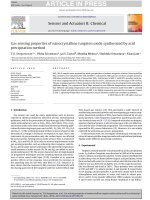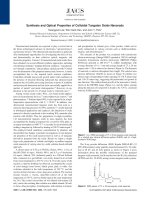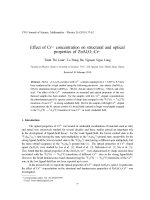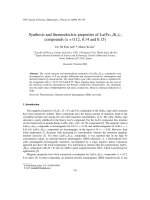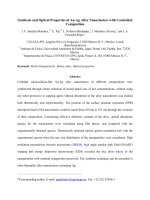- Trang chủ >>
- Khoa Học Tự Nhiên >>
- Vật lý
synthesis and optical properties of colloidal tungsten oxide nanorods
Bạn đang xem bản rút gọn của tài liệu. Xem và tải ngay bản đầy đủ của tài liệu tại đây (85.1 KB, 2 trang )
Synthesis and Optical Properties of Colloidal Tungsten Oxide Nanorods
Kwangyeol Lee, Won Seok Seo, and Joon T. Park*
National Research Laboratory, Department of Chemistry and School of Molecular Science (BK 21),
Korea AdVanced Institute of Science and Technology (KAIST), Daejeon 305-701, Korea
Received January 2, 2003; E-mail:
Nanostructured materials are expected to play a crucial role in
the future technological advance in electronics,
1
optoelectronics,
2
and memory devices.
3
One-dimensional nanostructures in particular
offer fundamental opportunities for investigating the effect of size
and dimensionality on their collective optical, magnetic, and
electronic properties. Various 1-D nanostructured metal oxides have
been obtained via several different synthetic approaches, including
solvothermal methods,
4
template-directed syntheses,
5
sonochemis-
try,
6
thermal evaporation,
7
and gas-phase catalytic growth.
8
Control
over the dimension of the prepared nanocrystals, however, is rarely
accomplished due to the required harsh reaction conditions.
Controlled colloidal nanocrystal growth under mild conditions in
the presence of structure-directing surfactants has attracted much
attention due to flexible processing chemistry in terms of solubility
and nanocrystal dimension and has been successfully applied for a
number of metals
9
and metal chalcogenides.
10
However, its ap-
plication to the growth of 1-D metal oxide is extremely rare.
11
Among various metal oxides, WO
3-x
has found useful applica-
tions in electrochromic devices,
12
semiconductor gas sensors,
13
and
photocatalyses.
14
Sodium-doped WO
3
is also reported to be a high-
temperature superconductor with T
c
≈ 90 K.
15
In addition, one-
dimensional nanostructured tungsten oxide has been used as a
structure-directing precursor for WS
2
nanotube,
16
a useful material
in tribological applications and catalyses; the dimension of oxide
nanorod is directly transferred to the resulting WS
2
nanotube after
reaction with H
2
/H
2
S. Thus far, preparation of single-crystalline,
1-D nanostructured tungsten oxide in mass quantity has been
accomplished by heating a tungsten foil, covered by SiO
2
plate, in
an argon atmosphere at 1600 °C
17
or recently by electrochemically
etching a tungsten tip, followed by heating at 700 °C under argon.
18
The employed harsh conditions, contamination by platelets, and
uncontrolled size hamper systematic investigations on size-depend-
ent properties of the oxide nanorod itself as well as of inorganic
derivatives prepared from the oxide. Herein we report a simple
large-scale preparation of soluble and highly crystalline tungsten
oxide nanorods of varying sizes by a mild, solution-based colloidal
approach.
A stirred slurry of 0.70 g of W(CO)
6
(Strem, 99%), 1.33 g of
Me
3
NO‚2H
2
O (6 equiv, Aldrich, 98%), and 8.5 g of oleylamine
(16 equiv, Aldrich, 70% (technical grade)) in a 100-mL Schlenk
tube, connected to a gas bubbler, was slowly heated in an oil bath
from room temperature to 270 °C over 2 h. Over the course of the
reaction, a vigorous frothing was observed, accompanied by a series
of color changes from brown, bluish green, pink, to white. Gas
evolution subsided at the bath temperature of 250 °C, and the
reaction mixture became a clear, deep-green solution. The reaction
mixture became a viscous, deep-blue-colored oil at the bath
temperature of 270 °C, and was further aged at the same temperature
for 24 h. The cooled viscous blue oil was diluted with toluene (20
mL), and to the resulting blue solution was added ethanol (50 mL)
to form a blue precipitate. Centrifugation, redissolution in toluene,
and precipitation by ethanol gave a blue powder, which can be
easily redispersed in various solvents such as dichloromethane,
toluene, and chlorobenzene.
19
The structure of the product was examined with transmission
electron microscopy (Omega EM912 operated at 120 kV) and high-
resolution transmission electron microscopy (HRTEM; Philips
F20Tecnai operated at 200 kV).
20
A rodlike morphology with
average diameter of 4 ( 1 nm and average length of 75 ( 20 nm
(aspect ratio ≈ 20) is observed as shown in Figure 1a. The diameter
of nanorods is uniform throughout their length. The selected area
electron diffraction (SAED) as shown in Figure 1b exhibits two
intense rings corresponding to lattice spacings of 3.78 Å (inner ring)
and 1.89 Å (outer ring), suggesting the preferential rod growth in
one direction. The unidirectional growth of the nanorods is clearly
shown in the HRTEM image (Figure 1c), and the lattice spacing
along the direction of rod growth is found to be 3.78 Å, consistent
with the SAED pattern.
The X-ray powder diffraction (XRD, Rigaku D/MAX-RC (12
kW) diffractometer using graphite-monochromatized Cu-K radia-
tion at 40 kV and 45 mA) pattern as shown in Figure 2 gives
information about the possible stoichiometry of the prepared
tungsten oxide nanorods, and it matches best the W
18
O
49
reflections
(JCPDS card No: 05-0392) among various tungsten oxide systems.
Figure 1.
(a) a TEM micrograph of 75 ( 20 nm tungsten oxide nanorods,
(b) a selected area electron diffraction pattern (SAED), and (c) a high-
resolution TEM image.
Figure 2.
XRD pattern of 75 ( 20 nm tungsten oxide nanorods.
Published on Web 02/26/2003
3408
9
J. AM. CHEM. SOC. 2003,
125
, 3408-3409 10.1021/ja034011e CCC: $25.00 © 2003 American Chemical Society
Comparing the intensities of the (010) and (014) peaks of the sample
with those of the bulk W
18
O
49
, it was found that the relative intensity
of (010) has been dramatically increased (from 100 to 225%),
implying that the nanorod growth occurs along 〈010〉 direction.
The length of the tungsten oxide nanorods can be easily varied
by simple changes in the reaction parameters. Shorter nanorods of
25 ( 6 nm in length (aspect ratio ≈ 10) were obtained at the
reaction temperature of 250 °C (Figure 3a).
19
Longer nanorods of
130 ( 30 nm in length (aspect ratio ≈ 20) were prepared at 270
°C by using 12 equiv of oleylamine instead of 16 equiv (Figure
3b).
19
At reaction temperatures below 250 °C, no nanorod formation
was observed, and contamination by platelets was observed at
reaction temperatures above 270 °C. Longer reaction time caused
little effects on the lengths of nanorods.
Little is known about the photoluminescence of nanostructured
tungsten oxides.
21
Figure 4 shows the room-temperature PL
emission spectra (Spex Fluorolog-3, 450 W Xe arc-lamp, excitation
at 275 nm) of the three tungsten oxide nanorod samples of various
lengths dissolved in dichloromethane.
The strongest PL emission peaks appear at 3.60 eV (344 nm),
3.56 eV (348 nm), 3.55 eV (349 nm) for short (25 ( 6 nm), medium
(75 ( 20 nm), and long (130 ( 30 nm) nanorod samples,
respectively. The very weak size-dependency of PL indicates that
the prepared tungsten oxide nanorod samples are on the border of
the quantum confinement regime. All three PL emission spectra
feature an additional blue emission peak at 2.84 eV (437 nm), and
the intensity of this peak increases relative to that of UV emission
as the length of nanorods increases. A similar PL pattern with two
emission maxima, yet at much lower energies of 2.8 and 2.3 eV,
was previously observed for thin film of the related WO
3
system
at 80 K, but the emission peak at higher energy (2.8 eV) disappeared
at room temperature.
22
While the higher-energy peak was attributed
to an electron-hole radiative recombination, the lower-energy peak
was assigned to localized states in the band gap due to impurities.
22b
In light of these assignments, we suggest that the UV emission of
nanorod samples in this work might correspond to the band-to-
band transition. The blue emission of nanorods might originate from
the presence of oxygen vacancies or defects; longer nanorods would
possess more defects due to faster 1-D crystal growth and thus more
intense PL emission associated with the presence of defects. Also,
the position of this blue emission peak does not show any size-
dependency, presumably, due to its irrelevance to the band structures
of the tungsten oxide system.
In summary, we have reported the first solution-based preparation
of soluble and highly crystalline tungsten oxide nanorods of varying
lengths, which might be easily scaled up, as well as their
photoluminescent behaviors at room temperature. The simple and
reliable synthetic procedure for a mass quantity of soluble tungsten
oxide nanorods would be very useful for practical application of
these materials as well as for the preparation of inorganic derivatives
such as WS
2
. Preliminary results show that the same synthetic
strategy can be applied to obtain nanorods of cobalt oxides, and
we are currently investigating the generality of our method for the
preparation of soluble 1-D nanostructured metal oxides.
Acknowledgment. This work was supported by the NRL
Program of the Korean Ministry of Science & Technology and by
the KOSEF (Project No. 1999-1-122-001-5). We thank the staffs
of KBSI and KAIST for TEM analyses. We also thank reviewers
for helpful comments.
References
(1) Cui, Y.; Lieber, C. M. Science 2001, 291, 851.
(2) Alivisatos, A. P. Science 1996, 271, 933.
(3) Sun, S.; Murray, C. B.; Weller, D.; Folks, L.; Moser, A. Science 2000,
287, 1989.
(4) Wang, X.; Li, Y. J. Am. Chem. Soc. 2002, 124, 2880.
(5) Patzke, G. R.; Krumeich, F.; Nesper, R. Angew. Chem., Int. Ed. 2002,
41, 2446; See references therein.
(6) Zhu, Y.; Li, H.; Koltypin, Y.; Hacohen, Y. R.; Gedanken, A. Chem.
Commun. 2001, 2616.
(7) Pan, Z. W.; Dai, Z. R.; Wang, Z. L. Science 2001, 291, 1947.
(8) Hu, J.; Odom, T. W.; Lieber, C. M. Acc. Chem. Res. 1999, 32, 435.
(9) (a) Jana, N. R.; Gearheart, L.; Murphy, C. J. Chem. Commun. 2001, 617.
(b) Dumestre, F.; Chaudret, B.; Amiens, C.; Fromen, M C.; Casanove,
M J.; Renaud, P.; Zurcher, P. Angew. Chem., Int. Ed. 2002, 41, 4286.
(10) (a) Lee, S M.; Jun, Y W.; Cho, S N.; Cheon, J. J. Am. Chem. Soc. 2002,
124, 11244. (b) Peng, X.; Manna, L.; Yang, W.; Wickham, J.; Scher, E.;
Kadavanich, A.; Alivisatos, A. P. Nature 2000, 404, 59.
(11) (a) Guo, L.; Ji, Y. L.; Xu, H.; Simon, P.; Wu, Z. J. Am. Chem. Soc. 2002,
124, 14864. (b) Urban, J. J.; Yun, W. S.; Gu, Q.; Park, H. J. Am. Chem.
Soc. 2002, 124, 1186.
(12) Santato, C.; Odziemkowski, M.; Ulmann, M.; Augustynski, J. J. Am. Chem.
Soc. 2001, 123, 10639.
(13) Solis, J. L.; Saukko, S.; Kish, L.; Granqvist, C. G.; Lantto, V. Thin Solid
Films 2001, 391, 255.
(14) Sayama, K.; Mukasa, K.; Abe, R.; Abe, Y.; Arakawa, H. Chem. Commun.
2001, 2416.
(15) Shengelaya, A.; Reich, S.; Tsabba, Y.; Mu¨ller, K. A. Eur. Phys. J. B 1998,
12, 13.
(16) Rothschild, A.; Sloan, J.; Tenne, R. J. Am. Chem. Soc. 2000, 122, 5169.
(17) Zhu, Y. Q.; Hu, W.; Hsu, W. K.; Terrones, M.; Grobert, N.; Hare, J. P.;
Kroto, H. W.; Walton, D. R. M.; Terrones, H. Chem. Phys. Lett. 1999,
309, 327.
(18) Gu, G.; Zheng, B.; Han, W. Q.; Roth, S.; Liu, J. Nano Lett. 2002, 2, 849.
(19) The toluene or chlorobenzene colloidal solutions of all three samples of
freshly prepared tungsten oxide nanorods are stable for several days at
room temperature, while CH
2
Cl
2
solutions are stable only for several hours.
No discernible difference in solubility was observed for the three samples.
(20) Samples for TEM investigations were prepared by transferring an aliquot
of toluene solution of W
18
O
49
or WO
2.72
nanorods onto an amorphous
carbon substrate supported on a copper grid.
(21) Niederberger, M.; Bartl, M. H.; Stucky, G. D. J. Am. Chem. Soc. 2002,
124, 13642.
(22) (a) Manfredi, M.; Paracchini, G. C.; Schianchi, G. Thin Solid Films 1981,
79, 161. (b) Paracchini, C.; Schianchi, G. Phys. Status Solidi A 1982, 72,
K129.
JA034011E
Figure 3.
TEM micrographs of (a) 3 ( 0.5 nm × 25 ( 6 nm and (b) 6 (
1.5 nm × 130 ( 30 nm tungsten oxide nanorods.
Figure 4.
Photoluminescence spectra of tungsten oxide nanorods; 25 ( 6
nm (short), 75 ( 20 nm (medium), and 130 ( 30 nm (long).
COMMUNICATIONS
J. AM. CHEM. SOC.
9
VOL. 125, NO. 12, 2003 3409

